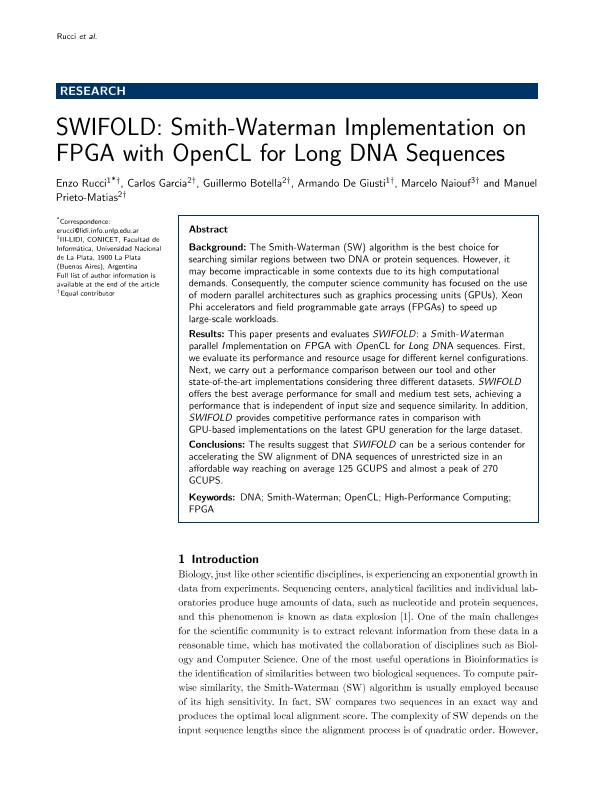Mostrar el registro sencillo del ítem
dc.contributor.author
Rucci, Enzo

dc.contributor.author
García Sanchez, Carlos
dc.contributor.author
Botella, Guillermo Juan
dc.contributor.author
de Giusti, Armando Eduardo

dc.contributor.author
Naiouf, Ricardo Marcelo

dc.contributor.author
Prieto Matías, Manuel
dc.date.available
2020-03-26T19:20:23Z
dc.date.issued
2018-02
dc.identifier.citation
Rucci, Enzo; García Sanchez, Carlos; Botella, Guillermo Juan; de Giusti, Armando Eduardo; Naiouf, Ricardo Marcelo; et al.; SWIFOLD: Smith-Waterman Implementation on FPGA with OpenCL for long DNA sequences; BioMed Central; Bmc Systems Biology; 12; 96; 2-2018; 43-53
dc.identifier.issn
1752-0509
dc.identifier.uri
http://hdl.handle.net/11336/100986
dc.description.abstract
Background: The Smith-Waterman (SW) algorithm is the best choice for searching similar regions between two DNA or protein sequences. However, it may become impracticable in some contexts due to its high computational demands. Consequently, the computer science community has focused on the use of modern parallel architectures such as graphics processing units (GPUs), Xeon Phi accelerators and field programmable gate arrays (FPGAs) to speed up large-scale workloads. Results: This paper presents and evaluates SWIFOLD: a Smith-Waterman parallel Implementation on FPGA with OpenCL for Long DNA sequences. First, we evaluate its performance and resource usage for different kernel configurations. Next, we carry out a performance comparison between our tool and other state-of-the-art implementations considering three different datasets. SWIFOLD offers the best average performance for small and medium test sets, achieving a performance that is independent of input size and sequence similarity. In addition, SWIFOLD provides competitive performance rates in comparison with GPU-based implementations on the latest GPU generation for the large dataset. Conclusions: The results suggest that SWIFOLD can be a serious contender for accelerating the SW alignment of DNA sequences of unrestricted size in an affordable way reaching on average 125 GCUPS and almost a peak of 270 GCUPS.
dc.format
application/pdf
dc.language.iso
eng
dc.publisher
BioMed Central

dc.rights
info:eu-repo/semantics/openAccess
dc.rights.uri
https://creativecommons.org/licenses/by-nc-sa/2.5/ar/
dc.subject
DNA
dc.subject
Smith-Waterman
dc.subject
OpenCL
dc.subject
HPC
dc.subject.classification
Otras Ciencias de la Computación e Información

dc.subject.classification
Ciencias de la Computación e Información

dc.subject.classification
CIENCIAS NATURALES Y EXACTAS

dc.title
SWIFOLD: Smith-Waterman Implementation on FPGA with OpenCL for long DNA sequences
dc.type
info:eu-repo/semantics/article
dc.type
info:ar-repo/semantics/artículo
dc.type
info:eu-repo/semantics/publishedVersion
dc.date.updated
2020-03-12T18:47:49Z
dc.journal.volume
12
dc.journal.number
96
dc.journal.pagination
43-53
dc.journal.pais
Reino Unido

dc.journal.ciudad
Londres
dc.description.fil
Fil: Rucci, Enzo. Universidad Nacional de la Plata. Facultad de Informatica. Instituto de Investigación En Informatica Lidi; Argentina. Consejo Nacional de Investigaciones Científicas y Técnicas. Centro Científico Tecnológico Conicet - La Plata; Argentina
dc.description.fil
Fil: García Sanchez, Carlos. Universidad Complutense de Madrid; España
dc.description.fil
Fil: Botella, Guillermo Juan. Universidad Complutense de Madrid; España
dc.description.fil
Fil: de Giusti, Armando Eduardo. Consejo Nacional de Investigaciones Científicas y Técnicas. Centro Científico Tecnológico Conicet - La Plata; Argentina. Universidad Nacional de la Plata. Facultad de Informatica. Instituto de Investigación En Informatica Lidi; Argentina
dc.description.fil
Fil: Naiouf, Ricardo Marcelo. Universidad Nacional de la Plata. Facultad de Informatica. Instituto de Investigación En Informatica Lidi; Argentina
dc.description.fil
Fil: Prieto Matías, Manuel. Universidad Complutense de Madrid; España
dc.journal.title
Bmc Systems Biology

dc.relation.alternativeid
info:eu-repo/semantics/altIdentifier/url/https://link.springer.com/article/10.1186%2Fs12918-018-0614-6
dc.relation.alternativeid
info:eu-repo/semantics/altIdentifier/doi/https://doi.org/10.1186/s12918-018-0614-6
dc.relation.alternativeid
info:eu-repo/semantics/altIdentifier/url/https://bmcsystbiol.biomedcentral.com/articles/10.1186/s12918-018-0614-6
Archivos asociados
